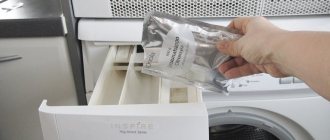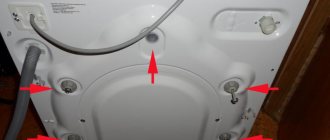We prepare the unit for moving
Before loading the machine into a vehicle, it must be protected with factory-made packaging material. When this is not available, you will need additional protection from foam pads, foam sheets, and soft blankets. Such options are considered more successful. Considering the fact that the factory box of the machine is stored for no more than the warranty period, then it is simply thrown away, you will have to use available options. In addition, the machine will have to be securely fixed so that it does not get damaged.
Transport the laundry washing unit as follows:
- Disconnect the SMA from the electrical network. Then the water supply and sewerage are turned off.
- The remaining water in the drum, hoses, pump and pipes is drained. If this is not done, then during carrying you can have several unpleasant moments or get some things wet. To drain the water as much as possible, the machine should be tilted and the free end of the hose should be lowered into a bucket or basin. Attempts to disconnect the hoses from the washing machine are prohibited, since these elements form an integral composition. After draining the water, the loading hatch should be left open so that the tank of the machine dries out better.
- All wires, hoses and pipes are secured. This action is performed with tape or plastic clamps. This measure will protect all of the listed elements from accidental damage.
- Each protruding element is fixed with tape. This way you will reliably protect not only the SMA, but also the objects surrounding it. Do not forget about the edges of the case so as not to damage the enamel coating.
- The drum is screwed through the rear panel with transport bolts to prevent it from rotating.
The washing machine is ready for transportation. All that remains is to securely fasten it in the body, making it impossible to move.
Many experts agree that the best option for transporting a laundry washing machine is in a vertical (standing) position. You just have to securely fasten the drum. Loading onto the vehicle body must be carried out vertically. If you have large items, it is recommended to install the machine tightly among them. During transportation, the unit must not be turned upside down. This is an exceptional case for new devices that do not contain a drop of moisture.
What can a violation of transportation rules lead to?
If you transport the washing machine incorrectly, certain problems may arise.
Damage to the power cord
Some people decide not to secure the power cable. This causes it to become damaged and stop working over time. To prevent this from happening, you need to fix the cord on the wall of the washing machine.
See also
How long does it take to charge a robot vacuum cleaner and what to do if it doesn’t happen?
Breakage of plastic parts of the case
The bodies of modern models of washing equipment have plastic elements that break easily. They can break due to improper placement of the machine in the vehicle or poor quality packaging of the structure.
Cuff rupture, hatch fastenings broken
It’s no secret that before transportation you need to close the washer hatch tightly so that it doesn’t dangle. If this is not done, serious problems may arise. Very often the cuff breaks, which leads to poor fixation of the hatch.
Failure of tank shock absorbers
The tank in which things are placed before washing must be securely fixed. If you do not secure it, it may fail during transportation and you will have to send the equipment in for repair.
Hoses and pipes may break
The pipes with hoses are secured to the walls of the device so that they do not dangle during transportation. Some people decide that this is not necessary and leave them unattached. Because of this, parts are torn and damaged.
Wetness and short circuiting of electrical wiring and contacts
Sometimes people do not care about high-quality packaging of equipment and transport it unpacked. This leads to moisture getting inside and onto the electrical wiring.
The control panel toggle switch may break off
There is a special toggle switch on the control panel, which is responsible for regulating the operation of the device. It may break if transported carelessly.
Drain pump failure
Each washing machine has a special drain pump responsible for pumping out waste liquid. If it breaks, you will have to seek help from specialists.
An unsecured powder container may break.
The compartments for storing powder and detergents must be sealed with tape so that they do not open. If this is not done, the cuvette will break on the road.
Is it possible to transport the machine without bolts?
Rarely does anyone remember about transportation bolts, because many people lose them soon after purchasing the machine. And if this happens, you will have to look for alternative options.
Washing equipment is often transported without such fasteners. In this case, it is necessary to remove the top panel to immobilize the elements inside.
After removing the body, arrange the gasket. It is not recommended to use hard elements - only foam rubber, rags or polystyrene foam.
Having filled the free space, screw the lid into place. Once the tank is immobile, protect the side walls. For this purpose, the body is wrapped in fabric and secured with cord.
Now you don’t have to worry about the safety of your equipment - everything will be delivered without damage.
Can it be transported without bolts?
When purchasing used appliances, there may be no bolts or they may be lost.
In this case, you need to remove the top wall of the washing machine and fill the free space with soft materials.
Can be used:
- rags;
- Styrofoam;
- foam rubber
Then the upper wall is put in place and secured with fasteners. Even during rough transportation, the drum and tank themselves will not be subject to impacts and damage the internal walls.
The outer casing of the equipment is also packaged in:
- corrugated cardboard;
- stretch film;
- textile.
Experienced experts recommend transporting the washing machine in an upright position, while securing the drum and tank.
When transported in a truck, the automatic machine is installed sideways in the direction of travel.
If other large items are transported in the back, the car must be placed between them so that it does not move, jump, or fall. This eliminates the risk of damaging shock absorbers, contacts and pipes.
Once the machine is packaged and ready for transportation, it must be carried safely to the vehicle, which can also cause problems. The hardest thing is to lower the unit from the upper floors without an elevator.
When descending from a floor, it is advisable to keep equipment in an upright position, in the same position as it will be used.
If this is not possible, then bend backwards.
If the packaging is insufficient, there is a risk that the doors will open during transportation. Although they are closed and held in place using special fasteners, it would be a good idea to secure them with tape or rope.
The empty drain hose is wound up and secured with tape or ties. Additionally, you can wrap them in polyethylene or soft material.
Loading into the car
It is easiest to load a car into a truck; questions usually arise with a passenger car.
There are several positions in which equipment can be transported:
- standing;
- on the side;
- on the back wall.
If the machine will be transported on its side, then the drum and tank may not be secured. Not all experts share this opinion, so it would not be superfluous to lay foam rubber between the mechanisms.
A used machine must be completely dry if it is planned to be transported on its side. Liquid may remain in the powder container. Getting the car body wet isn't as scary as damaging the electronics.
If you are not sure that the container is dry, it is better to wipe it dry or remove it and transport it separately.
Please note: if the washing machine is transported lying down, the powder container should not point upward (you need to focus on the model of the unit)
The manufacturer Zanussi differs in that it makes the fill valve near the counterweight. If you put the machine in an unnatural position, the valve breaks.
Before transporting the machine, you can place it on the back wall for a while to allow excess water to drain through the drain hose. Of course, the driver should drive as gently as possible and not stop or turn abruptly.
Is the washing machine transported lying down?
There are standard requirements for transporting a washing machine, which are necessarily listed in the instruction manual. The following conditions of carriage are stated there:
- it is performed only in vertical form,
- Before loading the drum is securely fixed, it is best to use special bolts,
- the machine must be dry,
- Factory packaging is used for transportation,
- the device is securely fastened in the car body,
- When moving, the driver should try to avoid sudden maneuvers and braking, and choose smooth sections of the road. In addition, the optimal speed mode is selected to avoid unnecessary maneuvers. If these recommendations are followed in full, then this guarantees almost one hundred percent success in delivering the product to its destination.
Naturally, every rule has its exceptions, which are determined by life situations. In such cases, you have to find the right way out so as not to damage the equipment. But remember that all violations of the instructions are fraught with consequences and will remain on the owner’s conscience.
In exceptional cases, it is allowed to transport the device lying down (on its side). The floor in the body is first lined with soft material or foam rubber. The machine is placed “on its back”, the sides with the drum and panel should remain on top. For the machine, the position “along” is determined in relation to the movement of the vehicle.
What are the dangers of improperly transporting a washing machine?
Before determining how to transport your washing machine - vertically, on its side or on the back, you should study the consequences of incorrect transportation. The worst that can happen is that the equipment stops functioning.
What can happen to the machine during transportation:
- the drain pump will break;
- the air conditioning compartment will fall out and crack;
- the control panel will become faulty;
- short circuit of electronics due to liquid getting into contacts and wiring;
- pipes and hoses will break;
- the shock absorber will break;
- the power cord breaks or becomes kinked;
- the cuff will tear;
- the hatch will break off;
- the body will break.
From the above malfunctions, it will not be possible to eliminate the breakdown of the case, as well as the loss of functionality of the machine. As soon as the equipment is delivered, remove the protective packaging from it and unscrew the shipping bolts. Only then can its functioning be checked. You will most likely still need the bolts, so it is recommended to pack them and secure them with adhesive tape on the back of the machine.
Before connecting equipment, make sure that the floor surface is level. Otherwise, the washer will start to leak during washing or stop working altogether.
Knowing how to properly transport an automatic washing machine, you can do this without damaging the equipment. Follow the recommendations listed above. It is important not only to pack the machine well, but also to choose the optimal position for transportation. This way you will eliminate shocks and falls, which means the machine will serve you for many years.
Some subtleties of transportation
Remember that the machine must not be turned over. It is better to carry her on her side or on her back than upside down. A certain amount of water will definitely remain inside, which can flow onto the panel responsible for general control. Repair work will be expensive in this case, so it is best to dry the machine thoroughly.
By the way, moisture can accumulate in the detergent tray. It is recommended to remove it and transport it separately from the main device. If this is not possible, wipe it with a dry cloth.
Remember that you can put all models and brands of cars on the back wall, except Zanussi. It is in it that the weighted counterweight elements are located so that in the given position “on the back” they are capable of damaging the valve responsible for water intake.
Definitely do not place the machine on the front wall. During transportation you will damage the loading hatch and rubber seal.
Is it possible to transport a washing machine lying down?
It also happens that transporting the machine in an upright position is impossible. How to transport a washing machine lying down? There are two options here: on the back panel or on the side.
Some owners of this household appliance are confident that they can transport the washing machine on its side without transport bolts.
However, it is recommended to always secure the drum, no matter in what position the equipment is transported.
Of course, the washing machine can be transported on its side. However, do not forget about the conditioner container. As soon as you lay the equipment on its side, most likely, all the water that has accumulated there will flow out of the compartment. If this happens, the control panel and contacts may get wet, which means that malfunctions will appear in the electronics.
To prevent this situation, you should remove this container during transportation and transport it separately. Or dry well in advance and wipe the inside.
How to properly transport a washing machine on the back panel? Follow these tips. So the equipment should be transported in the trunk or in the cabin, with something placed there in advance. Then, you will need to securely secure the machine to prevent shock during transportation. In addition, when transporting the “washing machine” with other large-sized equipment, try to squeeze it between objects, placing soft material between them.
Important! Transporting an automatic washing machine will be correct only when the air conditioner compartment does not point upward (the position may differ in different models).
All cars, with the exception of the Zanussi brand, can be transported on the rear panel.
What is the difference between Zanussi equipment? The fill valve is located next to the counterweight. Therefore, if the machine is placed in an unnatural way, it becomes unusable.
Another important recommendation on how to transport a washing machine - on its side or on the back: consider your driving style. So, you shouldn’t drive too fast, brake sharply and turn. By following these recommendations, you will be able to transport your automatic washing machine correctly.
What are the consequences of violating transportation rules?
Without studying the established rules, SMA owners quite often cause significant damage to the equipment during its transportation. Even a short trip of no more than fifteen minutes can result in complete failure of the device.
What can happen if transportation is disrupted:
- the power cord breaks,
- machine parts made of plastic material break,
- the rubber cuff of the loading hatch breaks,
- the hatch fastenings and its guides break off,
- shock absorbers fail,
- rubber components are torn - pipes, hoses,
- wires, contact groups are oxidized and short-circuited,
- The selector wheel on the control panel for setting programs breaks,
- the pump that drains the water loses its functionality,
- If you forget to fix the powder receiver, it can also be damaged.
Each of the breakdowns is eliminated, except for the damaged housing part or the complete loss of functionality of the electrical unit. Connecting the machine for testing is permitted after it has been completely unpacked and the bolts securing the drum have been removed. It is likely that they may be needed someday. The best storage option is in a plastic bag secured with tape on the back wall of the washing machine.
The machine should be installed in the designated place after the levelness of the floor has been checked. If this requirement is neglected, then during operation the unit may leak or “refuse” to perform the specified function.
To prevent anything like this from happening, the machine must be carefully prepared for the upcoming move and its movements from the bathroom to the new destination must be carefully monitored.
Loading Features
It’s good to carry the washing machine in a truck - then it can be placed vertically, secured or tied down. But it’s more difficult to do everything in a passenger car. Main loading methods:
- Standing (if there is a top trunk or the space allows for a regular one - but then you will have to drive with the trunk open).
- On one side.
- Lying on the back wall.
Important! If you decide to place the equipment on its side, make sure that the powder receptacle “looks” down.
The position of the housing depends on the make and model of the device. So, any car except Zanussi can be transported on the back wall. Why can't you experiment with Zanussi? It's simple: the fill valve in these models is located next to the counterweight, which can easily damage the part.
Is it possible to turn SM upside down? Not worth it. If this is the only option, then you will have to completely remove moisture from the system and dismantle the engine.
It is also not worth transporting it on the front wall in a car - you can tear the hatch cuff, damage the glass on the door or its fastenings. Repairs are inexpensive, but there is no need for extra hassle.
The unit must be transported by an experienced and calm driver who will avoid all potholes and potholes and avoid sudden braking and jerking.
Transporting a new unit
The cars are transported for the first time during purchase from the store to the apartment. Many people solve the problem simply - they buy the product and have it delivered to their doorstep. The device is packaged in a factory box and has reliable protection against negative effects. This option is convenient and is used by many retail stores as a free service if an expensive model is purchased.
Not only is there no need to look for a car and people for loading, but all responsibility for the integrity of the goods lies with the supplier, which in our case is the store. However, after delivery, it is recommended to check the device immediately - inspect the integrity of the packaging, completeness, and make sure there is no damage.
Expert advice
If the machine needs to be lowered from a multi-story building, you will have to try not to turn it over. Knowledgeable people assure that the device descends only in a vertical state, only slight inclinations are allowed. Such carrying is impossible for one person, so several people will be required for such an operation. The fact is that during careless carrying or installation the machine can be easily damaged.
It is not recommended to drag the washing machine around. There is a possibility of not only damage to the floor covering, but also to the body of the unit. The shape of the machine is streamlined, there are no additional handles for carrying, so you will have to tilt it a little whenever you move it. Before performing such “maneuvers,” it is better to enlist the help of another person who will secure the device from the opposite side.
If you don't have bolts to secure the drum, you can purchase them at a hardware store.











